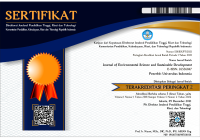Abstract
The increasing deforestation rate in the tropical peat landscape is impacting the sustainability of the peat ecosystem. Previous studies have monitored the deforestation on tropical forest using Landsat imagery. The analysis of forest landscape dynamics is crucial in understanding the functions of the sustainable ecosystem and to support sustainable development goals. The government controls the peat ecosystem function (PEF) based on the Indonesian Government Regulation No. 71/2014. However, a booming sago industry has resulted in smallholders establishing farms and expanding into the peatland. In this study, we conducted a spatiotemporal analysis of land use/cover changes based on a series of Landsat images from 1987–2016 along with a consideration of multidimensional factors, including the PEF, state forest land, and hotspots, to identify the mechanism and driving factors of the peat landscape dynamics. A qualitative approach was also used via interviews with 78 plantation smallholders to supplement the information obtained regarding the agricultural expansion. The observed land use/cover changes clearly indicate the conversion of forest into plantation land. The magnitude of the deforestation rate indicates the ongoing massive deforestation and spatial distribution of the protected PEF. Unproductive plantations within the state forest land totalled one-quarter of the Tebing Tinggi Island in 2016. The land use/cover change patterns indicate that timber extraction, peat fires, infrastructure development, and agriculture expansion are the driving factors. The actual minimum of income of plantation smallholders is leading to increases in unproductive land and poverty.
Recommended Citation
Sampurno, Dheny
(2019).
SPATIOTEMPORAL ANALYSIS IN MONITORING LANDSCAPE DYNAMIC PATTERNS IN TROPICAL PEAT ECOSYSTEM (STUDY IN TEBING TINGGI ISLAND, RIAU, INDONESIA).
Journal of Environmental Science and Sustainable Development, 2(1), 75-96.
Available at: https://doi.org/10.7454/jessd.v2i1.33






